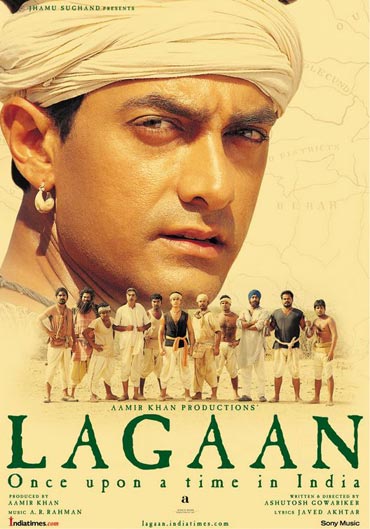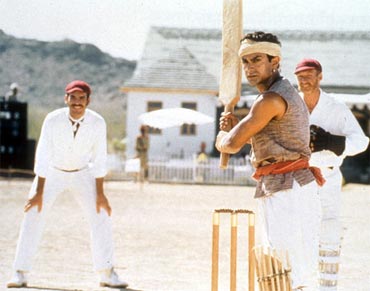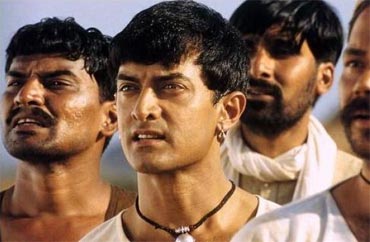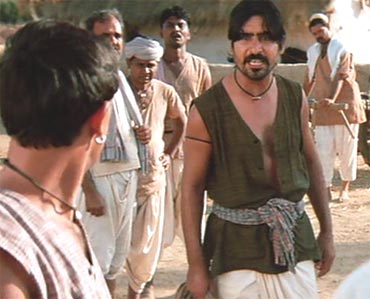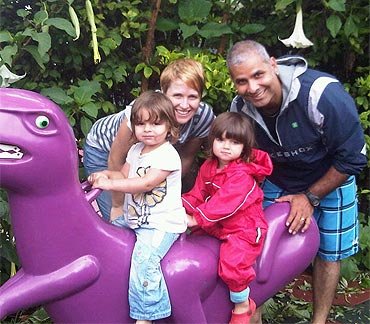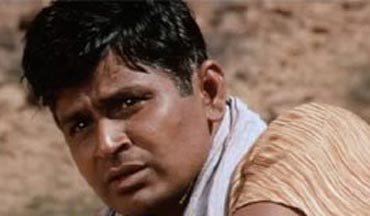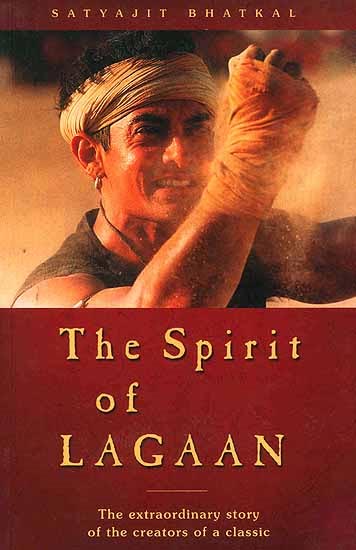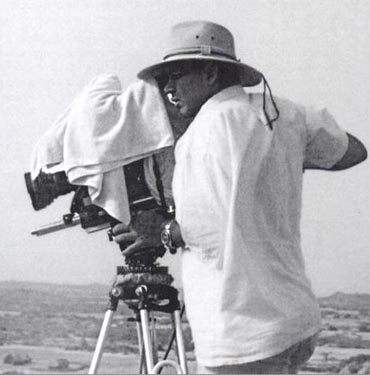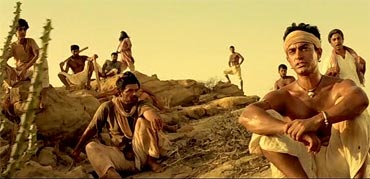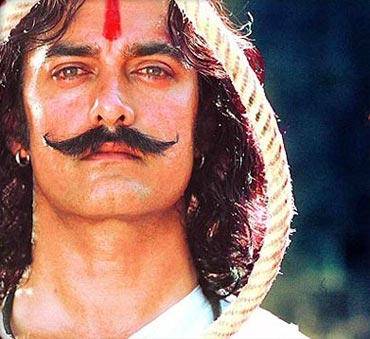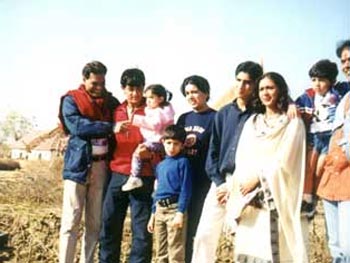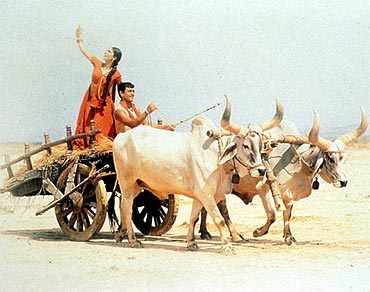 | « Back to article | Print this article |
Celebrating Lagaan, 10 years on
Suhasini Mulay stands on a barren piece of land somewhere in Bhuj, Gujarat, and looks up at the scorching sun. She is dressed in a white sari and has squinted her eyes as the sun shines mercilessly upon the arid landscape.
A few feet above her, cinematographer Anil Mehta sits on a giant crane with a movie camera aimed directly at Mulay.
After a few takes, everyone decides that the shot is good enough. From behind a monitor, Ashutosh Gowariker says 'Okay' into a microphone and is greeted by a round of applause.
Among the ones watching this scene unfold are Tahir Husain and Nasir Husain, the usually reticent AR Rahman, Aamir Khan's then wife Reena Datta, his to-be wife Kiran Rao and Khan himself.
Hugs and backslaps follow. Soon after, the guests make their way into the cars waiting for them. The others get back to work.
This is pretty much how it all began -- at around 11 am on January 6, 2000 -- the shooting of what would become one of the greatest films in Indian cinema and undoubtedly the biggest landmark movie of the decade that would follow: Lagaan.
Celebrating Lagaan, 10 years on
On June 15, 2001 the movie released amidst much anticipation. Rumours were flying thick and fast that Aamir Khan, the producer and the hero of the movie had finally lost his bearings.
Why else would anyone want to invest his time and money in a movie that had a 90-minute long cricket match as its climax?
Cricket-based movies have traditionally bombed at the box office -- one of them, Awwal Number, even had Aamir Khan in the lead!
At a little over three hours and 45 minutes, Lagaan was a terribly, terribly long film, not to mention that its very premise seemed featherbrained -- a group of villagers in pre-Independence India taking on an English team in a game of cricket in the hope that their lagaan or land tax for the next three years would be waived off.
Celebrating Lagaan, 10 years on
In the weeks that followed the release of Lagaan, the word spread like a wildfire -- the improbable story of an imaginary Indian village had caught the fancy of the nation.
It would win accolades not just in India but also across the world. At Locarno film festival, 8,500 people would sway to the tunes of Rahman and cheer for Bhuvan and his team even though they understood little of the language and absolutely nothing about the game of cricket.
Lagaan would become the first Indian movie to receive a nationwide release in China and an unprecedented nine-week golden run in Paris.
Special screenings would be held in Russia even as it travelled to film festivals across the world including Sundance, Cairo, Stockholm, Helsinki and Toronto.
Back home, it would sweep every single award worth its salt including seven National Awards and would go on to become only the third Hindi language movie after Mother India and Salaam Bombay to be nominated in the Best Foreign Language Film at the Academy Awards.
Despite all these accolades and the dizzying success, perhaps the greatest achievement of Lagaan is the fact that it is being talked about even 10 years after it first hit the screens.
Celebrating Lagaan, 10 years on
Even as Aamir Khan Productions is readying itself for its next release Delhi Belly starring Khan's nephew Imran -- he was all of 17 when Lagaan released -- questions about Lagaan haven't stopped.
Kiran Rao, who has been promoting Delhi Belly, if unwillingly, has had to take questions about the movie in press conferences. An interview request with Rao was denied because 'she was only the fourth AD (assistant director) on the film'.
She did however answer a couple of our questions in an open forum recently telling the media how time has flown and how Lagaan was a milestone in everyone's life before congratulating Ashutosh Gowariker who directed the film.
Rao went on to marry her boss, Aamir Khan after he divorced his first wife Reena Datta of 16 years. Recently, she directed the critically acclaimed film Dhobi Ghat that Khan agreed to produce and acted in.
Kiran Rao's wasn't the only one whose life changed after the movie.
Her colleagues -- Apoorva Lakhia and Reema Kagti who were assisting Gowariker -- also went on to make major Bollywood films.
Lakhia made Shootout at Lokhandwala a film based on a real life encounter in the eponymous Lokhandwala suburb of Mumbai.
Kagti went on to make Honeymoon Travels Pvt Ltd -- a charming tale about six unlikely couples on their respective honeymoons and is shooting her next, also starring Aamir Khan.
The fourth member of that team, Dr Priyamvada Narayanan went back to being a medical practitioner in the US till she realised where her true calling lay. So 10 years after she decided to try her hand at filmmaking, Priyamvada returned to India and is assisting Kagti on her new film.
Celebrating Lagaan, 10 years on
Lagaan will probably be remembered best for the cricket match that took up at least half the running time of the movie. And its most enduring image will be that of Aamir Khan and his teammates standing in a single file ready to take on the English team.
Staring at you with conviction, you would imagine that the life of each of these 10 men would have changed drastically after the movie.
After all, how many movies do you come across in Hindi cinema where each character stays with you years after the film's release?
But barring Yashpal Sharma who played Lakha, the woodcutter who rats on Bhuvan whose career pretty much catapulted after the movie, one cannot for a fact say that the movie made a world of a difference to most of the 'character actors'. Even the leading lady of the film, Gracy Singh couldn't really capitalise on the success of the movie.
Suhasini Mulay who played Aamir Khan's mother in the film points out that this happened because the match overshadowed the characters. She doesn't say this in a manner of complaining as much as a matter of fact.
"The climax itself is so powerful that all the build-up is lost," she says.
Lagaan, however, Mulay confesses, didn't get her any work per se.
What changed her life really was the film she'd done before Lagaan -- Gulzaar's Hu Tu Tu where she played a scheming and cold-hearted politician.
"Lagaan didn't change my life," she says over the phone. "By the time I was doing Lagaan I was at crossroads of my life. What got me going was Hu Tu Tu. (In fact) Ashutosh (Gowariker) spotted me while watching the promos of Hu Tu Tu."
Mulay who has completed her English honours and holds a diploma in agricultural technology had taken a break from movies early on in her career. After her first film -- the 1969 classic Bhuvan Shome -- Mulay stayed away from the limelight, focusing rather on making documentary films before a chance conversation with Gulzar led to Hu Tu Tu.
Celebrating Lagaan, 10 years on
Amin Hajee, who played Bagha the mute drummer, also confesses that he couldn't really capitalise on the success of Lagaan.
The actor had high hopes from Mangal Pandey -- his next movie after Lagaan -- but it failed to deliver and somewhere Hajee had lost himself. After Mangal Pandey, a string of flops followed.
As a writer, though, Hajee has had better luck. He wrote the screenplay of Swades and more recently scripted the story and the screenplay of the hit movie Haunted 3D.
Hajee also found the love of his life on the sets of Lagaan -- Charlotte.
"She had accompanied her brother (who plays an English cricketer in the movie) to India. I met her on the sets and as they say the rest is history. Today we are happily married and have twin daughters -- Summer and Sky."
Hajee however does confess that 'a handful of films have been able to do what Lagaan did in Indian cinema'.
"Today wherever I go and whatever I do, people recognise me and respect me because of my association with Lagaan."
Celebrating Lagaan, 10 years on
Aditya Lakhia, who played Kachra the untouchable spinner, says that Lagaan opened the doors of many producers for him.
"I have done more than 30 films after Lagaan, some of which have been very successful. It gave me recognition. Today I don't have to go knocking on the producer's doors for movies. It's just a phenomenal experience to be part of an epic (like Lagaan)," he gushes.
As mentioned earlier, Yashpal Sharma -- who played Lakha the woodcutter -- benefited from the movie.Sharma's portrayal of the mean-spirited Lakha went on to act in critically acclaimed films such as Ab Tak Chhappan, Hazaaron Khwaishein Aisi, Gangaajal and Chameli as well as blockbuster hits such as Singh is Kinng and more recently Yeh Saali Zindagi among others.
Sharma says, "It is difficult to get regular work in Bollywood but after Lagaan, things got easier for me. Post-Lagaan, I got to work with the top directors in the industry."
Celebrating Lagaan, 10 years on
If there was one man amongst the 10 villagers who was a star in his own right much before Lagaan, it was Raghubir Yadav. He'd played the immensely likeable Mungerilal in the television show Mungerilal ke Haseen Sapne.
Yadav, was also part of Salaam Bombay, one of the three Hindi language movies to go to the Oscars.
Lagaan may not have opened any new avenues for the actor as he continues to remain very selective about his films but Yadav says that it did change a lot of things for Hindi cinema.
"Hindi cinema got a new lease of life after Lagaan as filmmakers started taking risks and made some intelligent cinema.
Before Lagaan, there was a period where only bad films were being released, a lot of them having been copied from Hollywood. Lagaan changed that."
Movie critic-turned filmmaker S Ramachandran agrees. "Although films like Dilwale Dulhaniya Le Jayenge, Dil To Pagal Hai and Kuch Kuch Hota Hai had released overseas, Lagaan helped open the overseas market for Indian movies like never before," he says.
Celebrating Lagaan, 10 years on
As Derek Elley wrote in his review for Variety, the film 'could be the trigger for Bollywood's long-awaited crossover to non-ethnic markets'.
And indeed it was. Despite being formulaic in its own way, Lagaan had broken a lot of unwritten rules of Bollywood. It thus ended up being the face of the Hindi film industry in the west and its appeal went beyond the non-NRI market attracting crowds and raking in the moolah.
According to Ramachandran, Lagaan also infused a fresh lease of life in the Indian music industry. "Before Lagaan, the music scene had dropped for a bit. Rahman's music changed that," he says.
Interestingly, it was also around the same time that Rahman went international.
While he was working on the background score of Lagaan out of a room in Sahajanand Towers -- the apartment that the production house had booked for its cast and crew in Bhuj -- he was also preparing for his first major outing in the West, Andrew Lloyd Webber's musical Bombay Dreams.
According to Satyajit Bhatkal's book The Spirit of Lagaan, it was a race against time as Rahman worked nights (as he usually does) and completed the score before flying out.
Celebrating Lagaan, 10 years on
If there were two men who benefited hugely from the success of Lagaan, they were the films producer and director.
Before the filming of Lagaan, Khan was going through a lean patch. He had two flops behind him -- Mann and Mela. Khan's third was 1947: Earth, a movie that hardly got the adulation and welcome Khan is so used to.
Gowariker had even little to write home about.
His first movie was a 'remake' of the classic Body Double and Baazi, neither of which left the desired effect on the box office. Gowariker made his daily bread and butter acting in television serials on the sets of one of which he wrote the script of Lagaan.
Lagaan was a gamble and a very huge one at that.
Much to their relief, it paid off.
Gowariker was catapulted in the big league of directors. He went on to make Swades with Shah Rukh Khan and Jodhaa Akbar with Hrithik Roshan and Aishwarya Rai Bachchan.
It also put him in a position where he can sit back and not worry about the fact that his last two movies -- Khele Hum Jee Jaan Se and What's your Rashee? -- have failed miserably at the box office.
When we meet him at his office in Mumbai, Gowariker walks in, cool as a cucumber. An iPad in his hand and a confident stride, Gowariker greets us with a warm smile. If the failure of his most recent movies is bothering him, it doesn't show.
We talk about the movie and how it shaped him and his career.
In Madness in the Desert, the documentary about the making of Lagaan directed by Satyajit Bhatkal, Gowariker has spoken about his days before Lagaan happened -- how he made two movies he didn't entirely believe in, giving in to industry demands and how one fine day he decided that he would make a film he'd be proud of.
When we ask him how Lagaan changed his life, he takes a long pause before answering, "It gave me the courage to make films I believe in."
Celebrating Lagaan, 10 years on
According to media professional and industry observer, Abhijit Mhamunkar Lagaan also changed the way Bollywood perceived Gowariker and more especially Aamir Khan.
"Aamir got the power to dictate terms and conditions. He had taken a huge risk and it had worked. Filmmakers were in awe of him," he says. "The thing was Aamir has always known to be an interfering actor but with the success of Lagaan, directors were more open to incorporate his ideas. He began to have a greater say in the (creative process of his) movies. The perception was that Aamir simply couldn't be wrong!"
Mhamunkar further says that soon after the Oscar nominations, Khan was secretly pining for a major Hollywood movie.
"He kept waiting but no big offers came (his way). Meanwhile he also became sensitive about his career. After having delivered one of the greatest films in the history of Indian cinema, he couldn't be seen doing silly movies," Mhamunkar says.
While Gowariker and Bhatkal -- both of who have known Khan for years -- avoided talking about how Lagaan changed the actor, it is pretty evident from Khan's filmography.
His 27 pre-Lagaan films (not including the two where he was a child actor) include disasters such as Awwal Number, Parampara, Isi Ka Naam Zindagi, Daulat Ki Jung, Aatank Hi Aatank, Akele Hum Akele Tum, Ishq, Mann and Mela among others.
Celebrating Lagaan, 10 years on
Bhatkal, in fact, recollects an evening when a whole lot of them had gone to watch the just-released Mela at the beginning of their shooting schedule in Bhuj. "While returning, there was a stunned silence in the bus."
Weeks after the release of Lagaan came Dil Chahta Hai, yet another landmark movie that won a lot of accolades after which Khan went into four long years of hibernation.
His next film was Mangal Pandey: The Rising (2005), which though was an average grosser it wasn't a superhit like many had expected it to be.
Post-Mangal Pandey, Khan must have realised that there was only that much of period cinema his fans could handle and so the films that followed were stylish and contemporary.
2006 saw Rang De Basanti and Fanaa, 2007 belonged to Taare Zameen Par, Ghajini swept all records in 2008 and 3 Idiots in 2009.
Last year, he acted in his wife Kiran Rao's critically acclaimed (and comparatively) small budget movie, Dhobhi Ghat.
Technically, in the last 10 years, Khan hasn't had a single flop (Mangal Pandey was not a flop), no mean task for a 46-year-old actor during a decade where his contemporaries have stumbled, faltered and even fallen flat on their faces.
Celebrating Lagaan, 10 years on
Even as all these major players associated with Lagaan including Bhatkal, Lakhia, Rao and Kagti moved on to become public figures, one person disappeared from the scene entirely -- the film's executive producer and Aamir Khan's wife at the time: Reena Datta.
Datta is known to be a recluse and one who was never interested in being in the limelight. Her only tryst with celluloid, besides her marriage to Khan, was a blink-and-you'll-miss-it appearance in Aamir's debut vehicle -- Qayamat se Qayamat Tak.
In perhaps her only interview ever, Datta tells Satyajit Bhatkal in his documentary Madness in the Desert how she jumped headlong into the process of filmmaking for the first time ever at the behest of her husband.
Dressed in a bubblegum pink Lucknowi salwar kameez with a dupatta on her left shoulder, Datta speaks with the calm conviction of a woman who has stood solidly behind her man through thick and thin.
She tells Bhatkal how a casual suggestion to her husband to get organised in life if he means to produce a movie led her to be part of the landmark project.
As the National Award-winning documentary narrates the fascinating tale of the making of Lagaan, she reveals how she along with the venerable production veteran BS Rao visited Bhuj, finalised the nitty-gritty of where the team would stay, what they would eat and how the shoot would pan out and how much money would be spent.
Datta would go on to become the much-needed 'non-creative' voice who would fight to rein in the escalating production costs and hold on to a wild horse that would drag the fates of everyone associated with the film with it.
Celebrating Lagaan, 10 years on
Sometime in Feburary 2000, Datta would pay a surprise visit to the sets in Bhuj, call a meeting and threaten to discontinue the film entirely since the shoot was running way behind schedule.
As one goes back to the parts of the documentary with Datta in it, one cannot help but wonder how this mild-mannered lady could have transformed into a strict disciplinarian.
And yet she did, taking tough calls and making unpleasant decisions.
Satyajit Bhatkal's book The Spirit of Lagaan chronicles the various stages of the making of the film.
While he does provide vivid details about the process itself, one gets a feeling that there is very little insight into the people associated with it and how it affected their personal relationships. (Apoorva Lakhia's romance with Rachel Shelly is reduced to a single line for instance)
Similarly, the book provides little or no insight into what role the movie played in their relationship -- they broke up soon after the film's release.
On page 39 of the book though there is a hint of the pressures the movie put on their marriage:
June 1999
Aamir asks Reena to formally take over as the executive producer of the film. From that point on Aamir's role as producer is focussed only on the big policy decisions. At the operational level, Reena is the boss.
Reena's involvement has a strong romantic angle for Aamir. Not just personally, but professional too, they are building something together. It is a new and hitherto unexplored dimension to their relationship. They are both experiencing facets of the other's personality (sic) not fully known despite twelve years of married life. There is a growing mutual respect for new and different reasons. Yet, anything that has the power to build also has the power to destroy and neither nor Aamir nor Reena at this stage that their professional relationship in Lagaan will test their personal lives as never before.
Celebrating Lagaan, 10 years on
On January 6, 2000, Suhasini Mulay stands under the scorching sun.
A few feet above her, Anil Mehta sits on a giant crane with a movie camera aimed directly at Mulay.
After a few takes, everyone decides that the shot is good enough.
From behind a monitor, Ashutosh Gowariker says 'Okay' into a microphone and is greeted by a round of applause.
Among the ones watching this scene unfold are Tahir Husain and Nasir Husain, the usually reticent AR Rahman, Aamir Khan's then wife Reena Datta, his to-be wife Kiran Rao and Khan himself.
Soon after the shot is canned, everyone hugs everyone. There's a shot of Rahman uncomfortably moving away from the camera, a very, very happy Kiran Rao giving a thumbs up and Ashutosh Gowariker smiling.
There is also a shot of Reena Datta hugging Aamir Khan. It isn't a passionate hug, nor a one that would befit a chocolate hero of our generation. It seems like a hug between two professionals. Datta hugs Khan with one hand, the other is holding a still camera. Khan holds her for less than a second before the two look away in opposite directions.
Aamir's hand unwittingly reaches out to his nose, which he rubs cursorily, perhaps giving away a sign of discomfort. Then the camera pans away and the show goes on.
